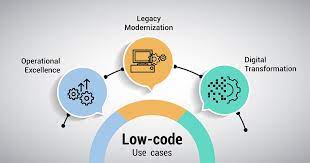Legacy modernization has gained growing significance in the business world, where the quality of technology often determines the success or failure of companies. Customers expect companies to offer technology solutions that are easy to use and reliable. Frequently, their choice of support relies on which company offers the most robust technological assistance.
The process of legacy modernization ensures that technological offerings evolve alongside the company and continue to meet the changing needs of customers. By paying close attention to the trends in legacy modernization, companies can ensure they remain competitive by providing the best technologies possible to their employees and customers. The following are some of the key legacy modernization trends for 2023.
1. Low-code platforms
For many organizations, the thought of modernizing legacy enterprise applications is simply overwhelming. One challenge lies in the necessity to develop new capabilities for existing applications. Integrating new code into these old platforms can involve a large investment of time and resources. Plus, the expansion of capabilities involves a considerable amount of risk because there is no guarantee the new functionality will work as intended. At times, even with a significant investment of time and resources, the desired functionality remains unattainable, which can have devastating consequences for a company. Low-code solutions reduce the time and resources required for such a change, consequently assisting in mitigating associated risks. If the endeavor doesn’t yield the desired results, it results in less time and money wasted.
The major hurdle to low-code platforms is finding a vendor to help create them. Many low-code vendors focus on bespoke app development rather than legacy modernization, but this may be changing as more organizations seek this sort of solution.
Another benefit of low-code platforms is the access they provide to cloud-native services. Low-code platforms make these services accessible despite the type of system employed by the platform, which allows for the integration of traditional and cloud-based tools. Certain low-code developers are capitalizing on this opportunity by offering solutions to organizations in search of legacy modernization, delivering straightforward methods to enhance their capabilities.
2. Cloud migration
Another significant trend in legacy modernization involves the migration of technological services to the cloud. While moving to the cloud takes a lot of planning and initial groundwork, it provides a lot of opportunity for future development. This is because the cloud makes scaling services easy. Plus, the cloud makes solutions accessible from virtually anywhere in the world, which ultimately means greater versatility in how teams are constructed and how they interact with each other. As a result, facilitating the integration of diverse perspectives and approaches has become more accessible than ever, significantly fueling the momentum behind cloud migration. With an increasing number of companies incorporating this into their broader legacy modernization strategies, a continuous stream of new options continues to emerge.
These options take advantage of cloud-native approaches to software development, such as containerization and microservices. The former involves placing all components necessary for an application to run in an environment together whereas the latter involves dividing software into smaller processes for easier scalability. These strategies ease the transition of legacy technologies to the cloud. Moving an entire system all at once can appear overwhelmingly daunting, yet these strategies enable a phased approach that fosters scalability. However, they are not without their challenges. A cloud-native approach necessitates a skill set that remains relatively uncommon and can prove costly to acquire. Consequently, numerous companies have experienced a slowdown in their development efforts when adopting cloud-native technologies.
3. Continuous development
DevOps has become increasingly widespread in recent years. This approach to business growth combines development and operations teams, fostering continuous feedback loops to enable ongoing development. A similar method can be employed in legacy modernization, where the system undergoes incremental improvements as individual components are addressed sequentially to progress toward a goal. The immediate and continual feedback of this approach usually results in systems that are finely tuned to meet the requirements of both employees and customers, ultimately offering a competitive edge. Additionally, this approach circumvents the downtime associated with implementing a new system and training employees.
The true power of the DevOps approach lies in collaboration. This strategy relies on the active involvement of diverse contributors, underscoring the importance of their collective efforts in attaining the best possible final product. Companies can continue to involve new voices in their development efforts according to the specific requirements of the project. Most importantly, this provides a framework for further collaboration and shows how traditional organizational silos can be broken down to create better products. In the end, the DevOps approach to legacy modernization looks different for every company, but it is achieving the same thing in terms of driving collaboration and causing a fundamental shift in how these large-scale processes take place. Small, continual change may prove more effective than complete system replacements.

